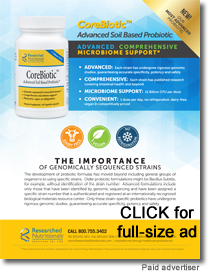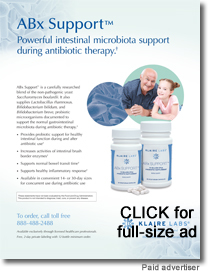|
Vitamin E: Nomenclature
"Vitamin E" refers to a group of eight naturally occurring compounds with antioxidant activity: alpha-, beta-, gamma-, and delta-tocopherol and alpha-, beta-, gamma-, and delta-tocotrienol. Tocotrienols have demonstrated some beneficial effects in humans, but they have not been well studied and will not be discussed in this article. Vitamin E was named "tocopherol," from Greek words meaning "to bear young," because it was found to be an essential nutrient for fertility in rats.
According to a standard assay (the rat fetal resorption assay), alpha-tocopherol has the highest biological activity of the four tocopherols, and it is the only form of vitamin E that is officially recognized as being capable of meeting human requirements. In addition, the vast majority of clinical research on vitamin E has used alpha-tocopherol. For these reasons, alpha-tocopherol is often considered to be synonymous with vitamin E. In this article, "vitamin E" generally refers to alpha-tocopherol unless otherwise specified.
Biological Effects of Gamma-Tocopherol
In contrast to alpha-tocopherol, gamma-tocopherol has very low vitamin E activity according to the rat fetal resorption assay.1 For that reason, its potential importance for human health has been largely overlooked. However, gamma-tocopherol has a number of other important biological effects, some of which are more pronounced than those of alpha-tocopherol. For example, gamma-tocopherol was more effective than alpha-tocopherol in inhibiting prostate cancer cell growth, reducing oxidative DNA damage, and increasing superoxide dismutase activity.2 Gamma-tocopherol or mixed tocopherols (which contain a high proportion of gamma-tocopherol) also inhibited platelet aggregation to a greater extent than did alpha-tocopherol.3,4 In addition, gamma-tocopherol was more effective than alpha-tocopherol at scavenging peroxynitrite. Peroxynitrite is a powerful mutagenic nitrating and oxidizing agent formed during the activation of phagocytes. It is believed to play a role in the pathogenesis of cardiovascular disease, cancer, and neurodegenerative diseases.5 Moreover, a metabolite of gamma-tocopherol – 2,7,8-trimethyl-2-(beta-carboxyethyl)-6-hydroxychroman (gamma-CEHC) – appears to function as a natriuretic hormone, in that it is involved in the body’s response to sodium-induced plasma volume expansion.6,7,8,9 This action as a natriuretic hormone raises the possibility that gamma-tocopherol could useful for preventing and treating congestive heart failure. In addition, according to a recent study in mice with experimentally induced diabetes, gamma-tocopherol has anti-inflammatory activity and enhances wound healing.10 Thus, while gamma-tocopherol is not capable of preventing classical manifestations of vitamin E deficiency, it appears to have useful functions.
 Alpha-Tocopherol Depletes Gamma-Tocopherol Alpha-Tocopherol Depletes Gamma-Tocopherol
The importance of considering gamma-tocopherol in human nutrition is underscored by reports that supplementation with alpha-tocopherol in doses of 200-1,200 IU per day decreased serum levels of gamma-tocopherol by accelerating its metabolism.2,11,12,13 As suggested below, it is possible that some of the adverse effects attributed to long-term vitamin E supplementation are due to alpha-tocopherol-induced gamma-tocopherol depletion.
Possible Implications for Heart Failure
In a double-blind study of patients with vascular disease or diabetes, supplementation with 400 IU per day of alpha-tocopherol for seven years resulted in a significant 19% increase in the incidence of heart failure compared with placebo.14 This adverse effect may have been due to alpha-tocopherol-induced gamma-tocopherol depletion, resulting in a deficiency of the natriuretic hormone, gamma-CEHC. If high-dose alpha-tocopherol does adversely affect cardiac function in some people, one might reasonably expect that mixed tocopherols, which contain all four isomers of vitamin E, would not have the same negative effects, and might even be beneficial.
Possible Implications for Prostate Cancer
Basic-science research and observational studies in humans suggest that alpha- and gamma-tocopherol might each help prevent prostate cancer. However, randomized controlled trials of alpha-tocopherol have produced conflicting results. In a randomized study of male smokers, supplementation with 50 IU per day of alpha-tocopherol for 5-8 years significantly decreased the incidence of prostate cancer by 31%.15 In contrast, in other double-blind trials, alpha-tocopherol at a dose of 200 IU per day had no effect on prostate cancer incidence,16 and at a dose of 400 IU per day for 5.5 years (with a total follow-up period of seven years) alpha-tocopherol significantly increased the incidence of prostate cancer by 17% compared with placebo (p < 0.01).17 These apparently contradictory findings might be explainable by a dose-related depletion of gamma-tocopherol by alpha-tocopherol. That possibility is supported by the dose-response relationship in the randomized controlled trials of alpha-tocopherol mentioned above: a protective effect with 50 IU per day, no effect with 200 IU per day, and a deleterious effect with 400 IU per day. Vitamin E might be more effective for cancer prevention if it is administered in the form of mixed tocopherols (which contain all four isomers of vitamin E) than if alpha-tocopherol alone is used.
Future Directions
Future studies of vitamin E for prevention of heart disease and cancer should use mixed tocopherols, rather than pure alpha-tocopherol.Furthermore, although much of the evidence is at present circumstantial, it would be reasonable to recommend mixed tocopherols instead of alpha-tocopherol when using vitamin E therapeutically.
 Mixed tocopherols are more expensive to produce than alpha-tocopherol, and some products labeled as vitamin E "with mixed tocopherols" contain only token amounts of mixed tocopherols. Reputable mixed-tocopherols products should specify the amount of gamma-tocopherol present. It has been my practice to recommend products that contain 50-100 mg of gamma-tocopherol per 400 IU (268 mg) of D-alpha-tocopherol. That ratio is in line with the ratio of gamma- to alpha-tocopherol in the European diet, although it is lower than the ratio in the American diet. Mixed tocopherols are more expensive to produce than alpha-tocopherol, and some products labeled as vitamin E "with mixed tocopherols" contain only token amounts of mixed tocopherols. Reputable mixed-tocopherols products should specify the amount of gamma-tocopherol present. It has been my practice to recommend products that contain 50-100 mg of gamma-tocopherol per 400 IU (268 mg) of D-alpha-tocopherol. That ratio is in line with the ratio of gamma- to alpha-tocopherol in the European diet, although it is lower than the ratio in the American diet.
References .pdf
|
![]()
![]()
![]()
![]()







